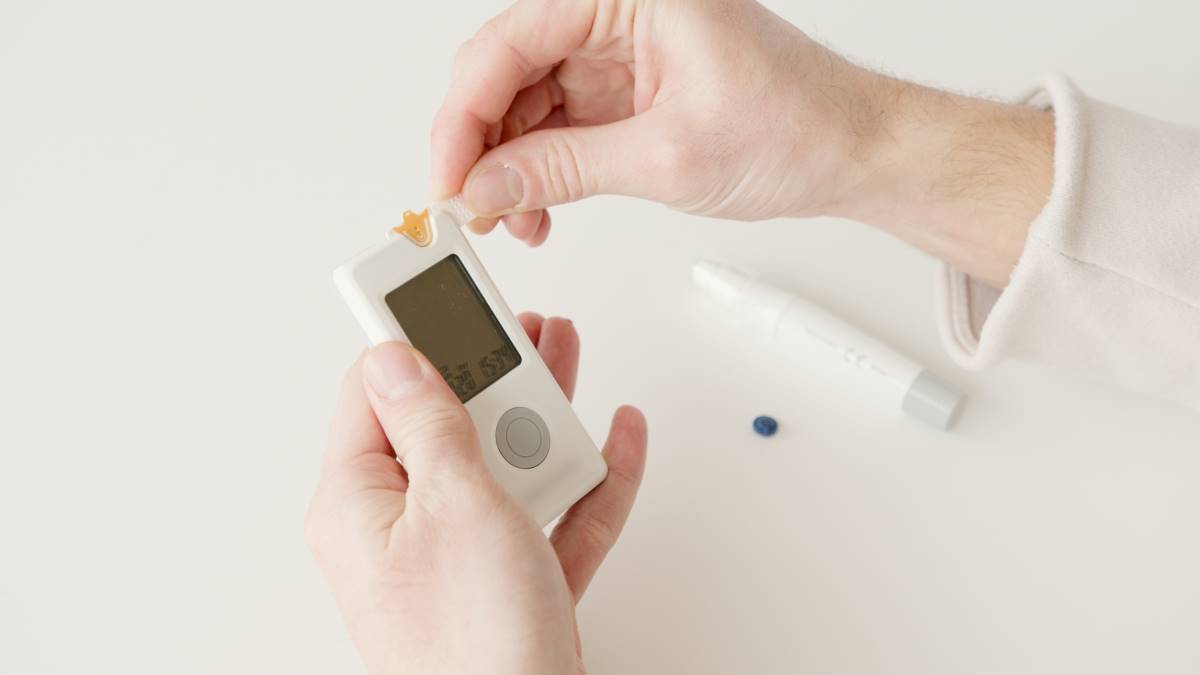The past decade has seen a surge in diabetes prevalence that shows no signs of slowing, in part due to the modern Western lifestyle[1].
Diabetes mellitus is just one condition that falls within the umbrella term ‘metabolic disease’, which typically also entails significantly increased risk of heart disease, high blood pressure, and lower life expectancy.
Fortunately, lifestyle factors like sleep, exercise, and diet play an essential role in diabetes risk management, which are all in your control. Read on to learn everything you need to know about diabetes.
The stats
- Diabetes ranks fifth highest among causes for death worldwide, affecting around one in 10 individuals in developed countries[2].
- One in eight people between the ages of 20 and 80 die early due to diabetes[3].
- Experts predict a 10-20% rise in diabetes prevalence in the next decade.
- People with diabetes are 80% more likely to suffer from heart attack and stroke[4].
- Men with diabetes are up to 75% more likely to experience erectile dysfunction[5].
- More than one in four women with diabetes suffer from problems with sexual and intimate health[6].
What is diabetes?
Diabetes mellitus is a disease that causes dysfunction throughout the body and alters how the body converts, stores, and uses food in the diet. As a result, diabetes often correlates with many other diseases, including obesity, cardiovascular disease, among others. People with diabetes are at an increased risk for nerve damage, infection and even the potential risk of limb amputation. Diabetic retinopathy is also a prevalent cause of blindness due to the long-term accumulation of pathological structural changes to the blood vessels supplying the retina.
Diabetes mellitus comes from the Greek word diabetes, which roughly translates to ‘excess production’ or ‘excretion’ of a substance, and mellitus, which roughly means ‘sweet’ or’ sugary’. Diabetes mellitus was so named because one of the symptoms is excessive excretion of glucose in the urine, or polyuria (excessive urination). In Ancient Greece, the primary method for diagnosing diabetes was tasting the urine for sweetness.
Two other symptoms in the ‘triad’ of diabetes symptoms are:
- Polydipsia (excessive thirst)
- Polyphagia (constantly elevated hunger)

Type 1 vs type 2 diabetes
Diabetes falls into two categories: type 1 and type 2. Type 1 diabetes is caused by an auto-immune disease in which insulin is entirely or almost absent from circulation, meaning that glucose in the blood cannot be appropriately managed or stored in tissues. These individuals’ immune systems cannot fully differentiate external and internal tissues, causing their immune system to ‘attack’ its tissues and cells as ‘foreign invaders’. In type 1 diabetes, an inappropriate immune response attacks the cells of the pancreas, the organ that produces insulin, hampering the body’s ability to regulate glucose appropriately[7].
Type 1 diabetes can present itself from birth, develop during early childhood or appear at any time because of an allergic reaction or an infection that becomes overzealous and attacks cells and tissues that aren’t diseased. Type 2 diabetes, however, is considered a ‘lifestyle’ disease, as it predominantly results from a combination of behavioural factors, such as poor diet, lack of activity, and poor sleep and stress management[8]. Unlike type 1 diabetes, it is more than possible to reverse type 2 diabetes with healthy lifestyle changes.
Diabetes diagnosis takes place through several means, one of which is the use of a glycated haemoglobin A1C (HbA1c) test. An HbA1c test measures advanced glycated end products (AGE) in the blood, which the body produces when blood glucose is chronically high. An HbA1c test is preferable to other forms of investigation as it accounts for daily fluctuations in blood sugars (affected by exercise, sleep, and stress, among other factors) by measuring your ‘average’ glucose levels over the past two to three months.

What causes diabetes?
Diabetes has been the subject of an ongoing debate regarding its causes, but there is no single agreed trigger. Instead, many factors coincide to produce an end-point that results in a type 2 diabetes diagnosis.
However, there are some broad risk factors for type 2 diabetes, that include:
- Obesity/ high BMI/ high body fat percentage.
- Older age.
- Genetic/familial history of type 2 diabetes.
- High blood pressure/hypertension.
- Lack of physical activity.
- Lack of sleep.
- Poor management of psychological stress.
- Poor blood lipids (specifically, low HDL, high LDL and high triglycerides).
- History of heart disease or stroke.
- Polycystic ovary syndrome[9].
These risk factors don’t always necessarily cause diabetes but often correlate with traits and behaviours of type 2 diabetic individuals.
One mechanism suggested as a cause of diabetes is the personal fat threshold theory (PFT), developed by researcher Roy Taylor[10]. PFT suggests that every individual has a threshold to store body fat under the skin (subcutaneous fat), where it’s most efficiently stored. Once your body exceeds this threshold, it becomes resistant to storing additional fat subcutaneously and turns to muscle tissue and organs like the liver and pancreas.
Whereas storing fat under your skin requires minimal effort regarding the body’s insulin requirements, storing fat in other sites requires higher levels of insulin. When a chronic calorie surplus results in fat gain, the body becomes resistant to storing nutrients, leaving high amounts of fat and glucose in the blood. Fat accumulation in areas like the liver and pancreas causes the body to produce more glucose than usual and hampers its ability to control insulin release appropriately. Overall, this results in ‘metabolic dysfunction’, which triggers a cascade of negative knock-on effects.
PFT helps explain why some individuals are obese but have not yet been diagnosed with diabetes, whereas ‘healthy’ weight individuals can have diabetes despite not appearing at risk. PFT also points towards a genetic component influencing diabetes risk, your predisposition to over-consume calories and your PFT.
It seems then that the primary cause of diabetes is an accumulation of excess body fat, caused by a toxic cocktail of too many calories, too little sleep, too little exercise, along with other negative lifestyle influences.

What are the risks of type 2 diabetes?
Type 2 diabetes is much more than a condition that affects your blood sugars; it is a metabolic disease that influences most of your organs and tissues. When your metabolism becomes impaired, many cells in your body lose access to the fuel they need to run effectively.
This metabolic dysfunction has implications for many bodily functions, including the immune system, brain function, growth and repair of your tissues, muscle function, among others. As a result, type 2 diabetes is linked to many chronic diseases and health conditions.
1. You’re more likely to suffer from heart disease or experience a heart attack or stroke.
Heart disease is the number one cause of death worldwide, and research shows that it affects one in three individuals with type 2 diabetes[11],[12]. Among the reasons for this association is the relationship between diabetes and blood pressure.
High blood pressure predicts a 92% increase in the risk for cardiovascular events and evidence shows that 85% of people with diabetes have unhealthy blood pressure[13],[14].
2. You’re more likely to lose lower body function or even have a limb amputated.
Diabetic foot ulcers (DFU) are the most common and severe direct risk among people with diabetes. A DFU is an open wound or sore that develops over time, which increases the risk for infection, and typically causes numbness and loss of function.
As many as one in four people with diabetes develop a diabetic foot ulcer, significantly increasing their risk for limb amputation[15]. 60% of non-traumatic lower-limb amputations worldwide result from diabetic complications, and 80% of these result from DFU[16].
3. Type 2 diabetes means you’re more likely to die young.
Studies report that people with diabetes live as many as 13 years less than non-diabetics and their risk for death by all causes is 82% higher[17],[18].
Life expectancy also decreases following diabetes-related lower limb amputations, with only around 41% of people with diabetes undergoing limb amputations survive for five years afterwards[19].
4. Diabetes can reduce your quality of life.
Individuals with type 2 diabetes consistently report a lower quality of life[20]. On average, people with diabetes are more likely to express struggles with physical functioning, anxiety, symptoms of depression, and overall life satisfaction[21].
Research also shows that people with diabetes are as much as 85% more likely to commit suicide due to health complications[22].

How does lifestyle impact diabetes risk?
Now you know what causes diabetes, let’s look at some of the most critical factors that can help you reduce risk, manage or even revert diabetes.
1. Diet
The nature of a disease that manifests over time means that its treatment and management require an extended (often lifelong) effort and intervention. Evidence doesn’t support any single quick fix or method for reversing type 2 diabetes, but one of the primary focal points for reducing and managing diabetes risk is diet. However, many misconceptions exist about what causes the disease and which dietary components help manage diabetes.
The evidence doesn’t support that there is any single ‘best’ diet for managing diabetes when we account for all factors. In a large research study among 20 different dietary approaches, researchers found that all methodologies were similarly effective at reducing diabetes-related symptoms. Importantly, these also resulted in a similar rate of change in diabetes-related risk factors seen with gold-standard medications[23]. Outcomes therefore appear to be relatively similar as long as the diet pattern is ‘healthy’ overall and energy balance and weight loss are equal.
One of the primary sources of controversy regarding weight loss and lifestyle disease management is the debate around whether high-carbohydrate-low-fat diets or high-fat-low-carbohydrate diets are best. However, the research shows that when adherence and caloric intake match, outcomes are relatively similar.

In one of the more comprehensive research studies on the topic, researchers found no practically significant difference between high- or low-carbohydrate diets regarding weight loss, body fat percentage, waist circumference, fasting glucose, or fasting insulin after 12 months. In addition, there were no significant increases in the numbers of participants diagnosed with metabolic syndrome (an umbrella of diseases under which type 2 diabetes falls) at baseline after this same period[24].
Evidence indicates that weight loss is the primary driver of type 2 diabetes reversal, not any particular type of diet. Research shows that diets balanced in composition and low in calories can help reverse type 2 diabetes in as little as eight weeks in severely obese patients[25]. Participants in this study achieved an average weight loss of 15kg, which may sound significant, but represented a small change relative to their body weight. Nevertheless, it demonstrates that even relatively small amounts of weight loss can produce substantial results in terms of diabetes-related markers.
Within one week, participants saw an almost 0.5% drop in HbA1c, a reduction that typically occurs only through medication. After one week of the intervention, fasting blood glucose and hepatic insulin sensitivity fell to normal levels. After 12 weeks of a maintenance diet and an average regain of around 3kg, participants maintained their normalised HbA1c, liver and pancreatic fat weight. This study highlights the importance of overall weight loss as opposed to any single dietary strategy. Therefore, when it comes to reversing and reducing the risk of diabetes, the main priority should be ensuring long-term dietary adherence and improving body composition.

2. Sleep
Evidence has mounted in recent years to support that sufficient good quality sleep is highly important for human health. Studies show that adults who sleep an average of six hours or less per night have an age-adjusted risk of all-cause mortality of 1.7 times that of individuals who sleep just one to two more hours per night[26]. This figure represents a 70% increased chance of death from all causes when we account for other variables.
Although sleep is not the only factor, it may be more than coincidental that rates of diabetes continue to increase at the same time as the duration and quality of sleep in the general population continues to fall. Large scale epidemiological studies have demonstrated that in the United States, sleep duration declined from eight to nine hours in the late 1950s to less than seven hours in the mid-2000s, with no signs of subsequent improvements[27].
Evidence suggests that individuals who sleep for six hours or less have a 25% and 91% higher risk of developing diabetes, respectively[28],[29]. For individuals sleeping for five or fewer hours per night, the relative risk increases to over 100% compared to individuals sleeping seven hours.
This also appears to be the case in different contexts and within other groups. For instance, there seems to be an association between perceived sleep debt (not achieving enough sleep) and HbA1c levels. One study comparing sleep debt and HbA1c levels identified a marked 2% increase in HbA1c between the highest and lowest tertials of perceived sleep debt[30].
Studies have also shown that there is an association between short sleepers and higher BMI levels. In one Japanese study, participants who slept less than six hours per night had double the odds of being obese. They also found that people who reported the lowest amount of sleep were three times more likely to be overweight or obese[31].
Sleep is a much-underappreciated tool when it comes to health overall, especially diabetes risk. Insufficient sleep is related to decreased insulin sensitivity and increases in appetite, cravings and sensitivity to pain[32],[33],[34]. Sleep is, therefore, a fundamental factor in controlling food intake, increasing activity levels and exercise performance, as well as directly impacting measures of diabetes, such as insulin sensitivity.

3. Exercise
The data shows that decreased risk of type 2 diabetes directly correlates with increased activity levels. This effect occurs via the direct impact of being more active and managing body weight and body composition[35].
A 2019 meta-analysis compared high and low total physical activity, leisure time activity, low, moderate and vigorous-intensity activity, resistance exercise as well as work-related activity and walking. Most of these activities resulted in a 25-40% decreased type 2 diabetes risk, while walking, occupational activity and cardiovascular fitness results in drops in risk of 15%, 15% and 55% respectively. Those who demonstrated consistently high levels of activity had a 36-41% reduced risk of developing the condition[36].
The evidence seems to show that all forms of exercise improve diabetes risk. Strength training, however, appears to be particular effective at managing insulin. In particular, resistance training at least three times per week appears to increase insulin action in skeletal muscle[37]
The evidence also shows that low muscle mass is a predictor of type 2 diabetes. Individuals with less relative muscle mass are significantly more at risk for type 2 diabetes, independent of obesity[38]. Therefore, resistance training offers several benefits when it comes to reversing type 2 diabetes:
Increased muscle mass increases the body’s ability to store glucose, reducing the levels of sugars circulating in the blood.
Larger muscles are typically more insulin sensitive, due to an increase in type 2 muscle fibres.
Resistance training increases muscle function (i.e. strength, coordination), which enhances the capacity to perform an adequate level of physical activity.

Our personal training programs focus on resistance training at Ultimate Performance to support better body composition and metabolic health with our clients.
How can you reduce your risk of diabetes?
While the physiological mechanisms that cause type 2 diabetes are numerous and complex, reducing your risk for type 2 diabetes is relatively simple.
1. Maintain a healthy body weight
The primary cause of diabetes is excess body fat. Therefore, the main goal for reversing type 2 diabetes is to maintain or achieve a healthy weight first before implementing any other specific supplements or measures.
2. Consume a balanced diet
This means including nutritionally dense foods composed of lean proteins, vegetables, fruits and healthy fats. If you are overweight or obese, your calorie intake should allow you to lose or at the very least maintain your current weight.
3. Incorporate resistance training
Training two to three times a week with high effort will allow you to build and retain muscle mass to support a healthy metabolism.
4. Increase your activity
Set a daily step goal that helps you to stay physically active each day and support weight management.
5. Prioritise high-quality sleep
Aim to sleep seven to nine hours each day, ideally with relatively similar waking and sleep times.
Incorporate good sleep hygiene practices, including putting away mobile devices an hour before bed, keeping your room cool and dark and avoiding stimulants in the hours before sleep.

Derailing diabetes prevalence
Type 2 diabetes presents a crucial health concern that has severe health implications that extend far more extensively than high blood sugars. While the trends in diabetes prevalence are bleak, diabetes is preventable and manageable with lifestyle and behavioural change.
Key Takeaways
- Type 2 diabetes ranks fifth highest among causes for death worldwide, affecting around one in 10 people in developed countries.
- Diabetes alters how the body converts, stores, and utilises nutrient intake.
- Whereas type I diabetes is an auto-immune disease in which a person cannot produce adequate insulin, type 2 diabetes is primarily caused by lifestyle and behavioural factors.
- The primary cause of type 2 diabetes is the accumulation of excess body fat.
- Diabetes is a severe condition that can increase your risk for cardiovascular disease, limb amputation, and reduce your life expectancy.
- Lifestyle modification the most effective way to reduce your risk of developing type 2 diabetes.



